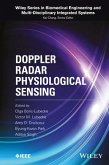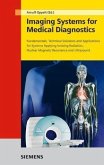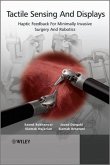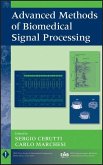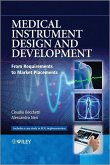Olga Boric-Lubecke, Victor M. Lubecke, Amy D. Droitcour, Byung-Kwon Park, Aditya Singh
Doppler Radar Physiological Sensing (eBook, PDF)
123,99 €
123,99 €
inkl. MwSt.
Sofort per Download lieferbar

0 °P sammeln
123,99 €
Als Download kaufen

123,99 €
inkl. MwSt.
Sofort per Download lieferbar

0 °P sammeln
Jetzt verschenken
Alle Infos zum eBook verschenken
123,99 €
inkl. MwSt.
Sofort per Download lieferbar
Alle Infos zum eBook verschenken

0 °P sammeln
Olga Boric-Lubecke, Victor M. Lubecke, Amy D. Droitcour, Byung-Kwon Park, Aditya Singh
Doppler Radar Physiological Sensing (eBook, PDF)
- Format: PDF
- Merkliste
- Auf die Merkliste
- Bewerten Bewerten
- Teilen
- Produkt teilen
- Produkterinnerung
- Produkterinnerung

Bitte loggen Sie sich zunächst in Ihr Kundenkonto ein oder registrieren Sie sich bei
bücher.de, um das eBook-Abo tolino select nutzen zu können.
Hier können Sie sich einloggen
Hier können Sie sich einloggen
Sie sind bereits eingeloggt. Klicken Sie auf 2. tolino select Abo, um fortzufahren.

Bitte loggen Sie sich zunächst in Ihr Kundenkonto ein oder registrieren Sie sich bei bücher.de, um das eBook-Abo tolino select nutzen zu können.
Presents a comprehensive description of the theory and practical implementation of Doppler radar-based physiological monitoring
This book includes an overview of current physiological monitoring techniques and explains the fundamental technology used in remote non-contact monitoring methods. Basic radio wave propagation and radar principles are introduced along with the fundamentals of physiological motion and measurement. Specific design and implementation considerations for physiological monitoring radar systems are then discussed in detail. The authors address current research and…mehr
- Geräte: PC
- ohne Kopierschutz
- eBook Hilfe
Andere Kunden interessierten sich auch für
![Doppler Radar Physiological Sensing (eBook, ePUB) Doppler Radar Physiological Sensing (eBook, ePUB)]() Olga Boric-LubeckeDoppler Radar Physiological Sensing (eBook, ePUB)123,99 €
Olga Boric-LubeckeDoppler Radar Physiological Sensing (eBook, ePUB)123,99 €![Imaging Systems for Medical Diagnostics (eBook, PDF) Imaging Systems for Medical Diagnostics (eBook, PDF)]() Imaging Systems for Medical Diagnostics (eBook, PDF)106,99 €
Imaging Systems for Medical Diagnostics (eBook, PDF)106,99 €![Tactile Sensing and Displays (eBook, PDF) Tactile Sensing and Displays (eBook, PDF)]() Javad DargahiTactile Sensing and Displays (eBook, PDF)98,99 €
Javad DargahiTactile Sensing and Displays (eBook, PDF)98,99 €![Biosensing Using Nanomaterials (eBook, PDF) Biosensing Using Nanomaterials (eBook, PDF)]() Biosensing Using Nanomaterials (eBook, PDF)171,99 €
Biosensing Using Nanomaterials (eBook, PDF)171,99 €![Introductory Bioelectronics (eBook, PDF) Introductory Bioelectronics (eBook, PDF)]() Ronald R. PethigIntroductory Bioelectronics (eBook, PDF)63,99 €
Ronald R. PethigIntroductory Bioelectronics (eBook, PDF)63,99 €![Advanced Methods of Biomedical Signal Processing (eBook, PDF) Advanced Methods of Biomedical Signal Processing (eBook, PDF)]() Advanced Methods of Biomedical Signal Processing (eBook, PDF)111,99 €
Advanced Methods of Biomedical Signal Processing (eBook, PDF)111,99 €![Medical Instrument Design and Development (eBook, PDF) Medical Instrument Design and Development (eBook, PDF)]() Claudio BecchettiMedical Instrument Design and Development (eBook, PDF)96,99 €
Claudio BecchettiMedical Instrument Design and Development (eBook, PDF)96,99 €-
-
-
Presents a comprehensive description of the theory and practical implementation of Doppler radar-based physiological monitoring
This book includes an overview of current physiological monitoring techniques and explains the fundamental technology used in remote non-contact monitoring methods. Basic radio wave propagation and radar principles are introduced along with the fundamentals of physiological motion and measurement. Specific design and implementation considerations for physiological monitoring radar systems are then discussed in detail. The authors address current research and commercial development of Doppler radar based physiological monitoring for healthcare and other applications.
Doppler Radar Physiological Sensing serves as a fundamental reference for radar, biomedical, and microwave engineers as well as healthcare professionals interested in remote physiological monitoring methods.
This book includes an overview of current physiological monitoring techniques and explains the fundamental technology used in remote non-contact monitoring methods. Basic radio wave propagation and radar principles are introduced along with the fundamentals of physiological motion and measurement. Specific design and implementation considerations for physiological monitoring radar systems are then discussed in detail. The authors address current research and commercial development of Doppler radar based physiological monitoring for healthcare and other applications.
- Explains pros and cons of different Doppler radar architectures, including CW, FMCW, and pulsed Doppler radar
- Discusses nonlinear demodulation methods, explaining dc offset, dc information, center tracking, and demodulation enabled by dc cancellation
- Reviews advanced system architectures that address issues of dc offset, spectrum folding, motion interference, and range resolution
- Covers Doppler radar physiological measurements demonstrated to date, from basic cardiopulmonary rate extractions to more involved volume assessments
Doppler Radar Physiological Sensing serves as a fundamental reference for radar, biomedical, and microwave engineers as well as healthcare professionals interested in remote physiological monitoring methods.
Dieser Download kann aus rechtlichen Gründen nur mit Rechnungsadresse in D ausgeliefert werden.
Produktdetails
- Produktdetails
- Verlag: Wiley
- Erscheinungstermin: 14. Dezember 2015
- Englisch
- ISBN-13: 9781119078425
- Artikelnr.: 44414350
- Verlag: Wiley
- Erscheinungstermin: 14. Dezember 2015
- Englisch
- ISBN-13: 9781119078425
- Artikelnr.: 44414350
- Herstellerkennzeichnung Die Herstellerinformationen sind derzeit nicht verfügbar.
Olga Boric-Lubecke, PhD, is a Professor of Electrical Engineering at the University of Hawaii at Manoa, and an IEEE Fellow. She is widely recognized as a pioneer and leader in microwave radar technologies for non-contact cardiopulmonary monitoring, and in the design of integrated circuits for biomedical applications.
Victor M. Lubecke, PhD, is a Professor of Electrical Engineering at the University of Hawaii at Manoa. He is an emeritus IEEE Distinguished Microwave Lecturer and has over 25 years of experience in research and development of devices and methods for radio-based remote sensing systems.
Amy Droitcour, PhD, has spent ten years developing radar-based vital signs measurement technology through her dissertation research and leading product development as CTO of Kai Medical. She currently serves as Senior Vice President of R&D at Wave 80 Biosciences.
Byung-Kwon-Park, PhD, is a senior research engineer at the Mechatronics R&D Center in Korea.
Aditya Singh, PhD, is currently a postdoctoral researcher at the University of Hawaii Neuroscience and MRI research Program.
Victor M. Lubecke, PhD, is a Professor of Electrical Engineering at the University of Hawaii at Manoa. He is an emeritus IEEE Distinguished Microwave Lecturer and has over 25 years of experience in research and development of devices and methods for radio-based remote sensing systems.
Amy Droitcour, PhD, has spent ten years developing radar-based vital signs measurement technology through her dissertation research and leading product development as CTO of Kai Medical. She currently serves as Senior Vice President of R&D at Wave 80 Biosciences.
Byung-Kwon-Park, PhD, is a senior research engineer at the Mechatronics R&D Center in Korea.
Aditya Singh, PhD, is currently a postdoctoral researcher at the University of Hawaii Neuroscience and MRI research Program.
List of Contributors xi 1 Introduction 1 Amy D. Droitcour
Olga Boric-Lubecke
Shuhei Yamada
and Victor M. Lubecke 1.1 Current Methods of Physiological Monitoring
2 1.2 Need for Noncontact Physiological Monitoring
3 1.2.1 Patients with Compromised Skin
3 1.2.2 Sleep Monitoring
4 1.2.3 Elderly Monitoring
5 1.3 Doppler Radar Potential for Physiological Monitoring
5 1.3.1 Principle of Operation and Power Budget
6 1.3.2 History of Doppler Radar in Physiological Monitoring
8 References
16 2 Radar Principles 21 Ehsan Yavari
Olga Boric-Lubecke
and Shuhei Yamada 2.1 Brief History of Radar
21 2.2 Radar Principle of Operation
22 2.2.1 Electromagnetic Wave Propagation and Reflection
23 2.2.2 Radar Cross Section
24 2.2.3 Radar Equation
25 2.3 Doppler Radar
28 2.3.1 Doppler Effect
28 2.3.2 Doppler Radar Waveforms: CW
FMCW
Pulsed
29 2.4 Monostatic and Bistatic Radar
32 2.5 Radar Applications
35 References
36 3 Physiological Motion and Measurement 39 Amy D. Droitcour and Olga Boric-Lubecke 3.1 Respiratory System Motion
39 3.1.1 Introduction to the Respiratory System
39 3.1.2 Respiratory Motion
40 3.1.3 Chest Wall Motion Associated with Breathing
43 3.1.4 Breathing Patterns in Disease and Disorder
43 3.2 Heart System Motion
44 3.2.1 Location and Gross Anatomy of the Heart
45 3.2.2 Electrical and Mechanical Events of the Heart
46 3.2.3 Chest Surface Motion Due to Heart Function
48 3.2.4 Quantitative Measurement of Chest Wall Motion Due to Heartbeat
50 3.3 Circulatory System Motion
53 3.3.1 Location and Structure of the Major Arteries and Veins
54 3.3.2 Blood Flow Through Arteries and Veins
55 3.3.3 Surface Motion from Blood Flow
56 3.3.4 Circulatory System Motion: Variation with Age
57 3.4 Interaction of Respiratory
Heart
and Circulatory Motion at the Skin Surface
58 3.5 Measurement of Heart and Respiratory Surface Motion
58 3.5.1 Radar Measurement of Physiological Motion
59 3.5.2 Surface Motion Measurement of Respiration Rate
59 3.5.3 Surface Motion Measurement of Heart/Pulse Rate
61 References
63 4 Physiological Doppler Radar Overview 69 Aditya Singh
Byung-Kwon Park
Olga Boric-Lubecke
Isar Mostafanezhad
and Victor M. Lubecke 4.1 RF Front End
70 4.1.1 Quadrature Receiver
73 4.1.2 Phase Coherence and Range Correlation
77 4.1.3 Frequency Choice
79 4.1.4 Antenna Considerations
80 4.1.5 Power Budget
80 4.2 Baseband Module
83 4.2.1 Analog Signal Conditioning and Coupling Methods
83 4.2.2 Data Acquisition
85 4.3 Signal Processing
86 4.3.1 Phase Demodulation
86 4.3.2 Demodulated Phase Processing
87 4.4 Noise Sources
90 4.4.1 Electrical Noise
90 4.4.2 Mechanical Noise
92 4.5 Conclusions
92 References
93 5 CW Homodyne Transceiver Challenges 95 Aditya Singh
Alex Vergara
Amy D. Droitcour
Byung-Kwon Park
Olga Boric-Lubecke
Shuhei Yamada
and Victor M. Lubecke 5.1 RF Front End
95 5.1.1 Single-Channel Limitations
96 5.1.2 LO Leakage Cancellation
103 5.1.3 IQ Imbalance Assessment
109 5.2 Baseband Module
113 5.2.1 AC and DC Coupling
113 5.2.2 DC Canceller
114 5.3 Signal Demodulation
118 5.3.1 DC Offset and DC Information
118 5.3.2 Center Tracking
125 5.3.3 DC Cancellation Results
130 References
134 6 Sources of Noise and Signal-to-Noise Ratio 137 Amy D. Droitcour
Olga Boric-Lubecke
and Shuhei Yamada 6.1 Signal Power
Radar Equation
and Radar Cross Section
138 6.1.1 Radar Equation
138 6.1.2 Radar Cross Section
140 6.1.3 Reflection and Absorption
141 6.1.4 Phase-to-Amplitude Conversion
141 6.2 Oscillator Phase Noise
Range Correlation and Residual Phase Noise
143 6.2.1 Oscillator Phase Noise
143 6.2.2 Range Correlation and Residual Phase Noise
147 6.3 Contributions of Various Noise Sources
151 6.3.1 Phase Noise
151 6.3.2 Baseband 1/f Noise
154 6.3.3 RF Additive White Gaussian Noise
154 6.4 Signal-to-Noise Ratio
155 6.5 Validation of Range Correlation
157 6.6 Human Testing Validation
158 References
168 7 Doppler Radar Physiological Assessments 171 John Kiriazi
Olga Boric-Lubecke
Shuhei Yamada
Victor M. Lubecke
and Wansuree Massagram 7.1 Actigraphy
172 7.2 Respiratory Rate
176 7.3 Tidal Volume
179 7.4 Heart Rates
184 7.5 Heart Rate Variability
185 7.6 Respiratory Sinus Arrhythmia
190 7.7 RCs and Subject Orientation
196 References
204 8 Advanced Performance Architectures 207 Aditya Singh
Aly Fathy
Isar Mostafanezhad
Jenshan Lin
Olga Boric-Lubecke
Shuhei Yamada
Victor M. Lubecke
and Yazhou Wang 8.1 DC Offset and Spectrum Folding
208 8.1.1 Single-Channel Homodyne System with Phase Tuning
208 8.1.2 Heterodyne System with Frequency Tuning
213 8.1.3 Low-IF Architecture
220 8.2 Motion Interference Suppression
224 8.2.1 Interference Cancellation
226 8.2.2 Bistatic Radar: Sensor Nodes
231 8.2.3 Passive RF Tags
240 8.3 Range Detection
250 8.3.1 Physiological Monitoring with FMCW Radar
250 8.3.2 Physiological Monitoring with UWB Radar
251 References
266 9 Applications and Future Research 269 Aditya Singh and Victor M. Lubecke 9.1 Commercial Development
269 9.1.1 Healthcare
269 9.1.2 Defense
272 9.2 Recent Research Areas
272 9.2.1 Sleep Study
272 9.2.2 Range
275 9.2.3 Multiple Subject Detection
276 9.2.4 Animal Monitoring
279 9.3 Conclusion
282 References
282 Index 285
Olga Boric-Lubecke
Shuhei Yamada
and Victor M. Lubecke 1.1 Current Methods of Physiological Monitoring
2 1.2 Need for Noncontact Physiological Monitoring
3 1.2.1 Patients with Compromised Skin
3 1.2.2 Sleep Monitoring
4 1.2.3 Elderly Monitoring
5 1.3 Doppler Radar Potential for Physiological Monitoring
5 1.3.1 Principle of Operation and Power Budget
6 1.3.2 History of Doppler Radar in Physiological Monitoring
8 References
16 2 Radar Principles 21 Ehsan Yavari
Olga Boric-Lubecke
and Shuhei Yamada 2.1 Brief History of Radar
21 2.2 Radar Principle of Operation
22 2.2.1 Electromagnetic Wave Propagation and Reflection
23 2.2.2 Radar Cross Section
24 2.2.3 Radar Equation
25 2.3 Doppler Radar
28 2.3.1 Doppler Effect
28 2.3.2 Doppler Radar Waveforms: CW
FMCW
Pulsed
29 2.4 Monostatic and Bistatic Radar
32 2.5 Radar Applications
35 References
36 3 Physiological Motion and Measurement 39 Amy D. Droitcour and Olga Boric-Lubecke 3.1 Respiratory System Motion
39 3.1.1 Introduction to the Respiratory System
39 3.1.2 Respiratory Motion
40 3.1.3 Chest Wall Motion Associated with Breathing
43 3.1.4 Breathing Patterns in Disease and Disorder
43 3.2 Heart System Motion
44 3.2.1 Location and Gross Anatomy of the Heart
45 3.2.2 Electrical and Mechanical Events of the Heart
46 3.2.3 Chest Surface Motion Due to Heart Function
48 3.2.4 Quantitative Measurement of Chest Wall Motion Due to Heartbeat
50 3.3 Circulatory System Motion
53 3.3.1 Location and Structure of the Major Arteries and Veins
54 3.3.2 Blood Flow Through Arteries and Veins
55 3.3.3 Surface Motion from Blood Flow
56 3.3.4 Circulatory System Motion: Variation with Age
57 3.4 Interaction of Respiratory
Heart
and Circulatory Motion at the Skin Surface
58 3.5 Measurement of Heart and Respiratory Surface Motion
58 3.5.1 Radar Measurement of Physiological Motion
59 3.5.2 Surface Motion Measurement of Respiration Rate
59 3.5.3 Surface Motion Measurement of Heart/Pulse Rate
61 References
63 4 Physiological Doppler Radar Overview 69 Aditya Singh
Byung-Kwon Park
Olga Boric-Lubecke
Isar Mostafanezhad
and Victor M. Lubecke 4.1 RF Front End
70 4.1.1 Quadrature Receiver
73 4.1.2 Phase Coherence and Range Correlation
77 4.1.3 Frequency Choice
79 4.1.4 Antenna Considerations
80 4.1.5 Power Budget
80 4.2 Baseband Module
83 4.2.1 Analog Signal Conditioning and Coupling Methods
83 4.2.2 Data Acquisition
85 4.3 Signal Processing
86 4.3.1 Phase Demodulation
86 4.3.2 Demodulated Phase Processing
87 4.4 Noise Sources
90 4.4.1 Electrical Noise
90 4.4.2 Mechanical Noise
92 4.5 Conclusions
92 References
93 5 CW Homodyne Transceiver Challenges 95 Aditya Singh
Alex Vergara
Amy D. Droitcour
Byung-Kwon Park
Olga Boric-Lubecke
Shuhei Yamada
and Victor M. Lubecke 5.1 RF Front End
95 5.1.1 Single-Channel Limitations
96 5.1.2 LO Leakage Cancellation
103 5.1.3 IQ Imbalance Assessment
109 5.2 Baseband Module
113 5.2.1 AC and DC Coupling
113 5.2.2 DC Canceller
114 5.3 Signal Demodulation
118 5.3.1 DC Offset and DC Information
118 5.3.2 Center Tracking
125 5.3.3 DC Cancellation Results
130 References
134 6 Sources of Noise and Signal-to-Noise Ratio 137 Amy D. Droitcour
Olga Boric-Lubecke
and Shuhei Yamada 6.1 Signal Power
Radar Equation
and Radar Cross Section
138 6.1.1 Radar Equation
138 6.1.2 Radar Cross Section
140 6.1.3 Reflection and Absorption
141 6.1.4 Phase-to-Amplitude Conversion
141 6.2 Oscillator Phase Noise
Range Correlation and Residual Phase Noise
143 6.2.1 Oscillator Phase Noise
143 6.2.2 Range Correlation and Residual Phase Noise
147 6.3 Contributions of Various Noise Sources
151 6.3.1 Phase Noise
151 6.3.2 Baseband 1/f Noise
154 6.3.3 RF Additive White Gaussian Noise
154 6.4 Signal-to-Noise Ratio
155 6.5 Validation of Range Correlation
157 6.6 Human Testing Validation
158 References
168 7 Doppler Radar Physiological Assessments 171 John Kiriazi
Olga Boric-Lubecke
Shuhei Yamada
Victor M. Lubecke
and Wansuree Massagram 7.1 Actigraphy
172 7.2 Respiratory Rate
176 7.3 Tidal Volume
179 7.4 Heart Rates
184 7.5 Heart Rate Variability
185 7.6 Respiratory Sinus Arrhythmia
190 7.7 RCs and Subject Orientation
196 References
204 8 Advanced Performance Architectures 207 Aditya Singh
Aly Fathy
Isar Mostafanezhad
Jenshan Lin
Olga Boric-Lubecke
Shuhei Yamada
Victor M. Lubecke
and Yazhou Wang 8.1 DC Offset and Spectrum Folding
208 8.1.1 Single-Channel Homodyne System with Phase Tuning
208 8.1.2 Heterodyne System with Frequency Tuning
213 8.1.3 Low-IF Architecture
220 8.2 Motion Interference Suppression
224 8.2.1 Interference Cancellation
226 8.2.2 Bistatic Radar: Sensor Nodes
231 8.2.3 Passive RF Tags
240 8.3 Range Detection
250 8.3.1 Physiological Monitoring with FMCW Radar
250 8.3.2 Physiological Monitoring with UWB Radar
251 References
266 9 Applications and Future Research 269 Aditya Singh and Victor M. Lubecke 9.1 Commercial Development
269 9.1.1 Healthcare
269 9.1.2 Defense
272 9.2 Recent Research Areas
272 9.2.1 Sleep Study
272 9.2.2 Range
275 9.2.3 Multiple Subject Detection
276 9.2.4 Animal Monitoring
279 9.3 Conclusion
282 References
282 Index 285
List of Contributors xi 1 Introduction 1 Amy D. Droitcour
Olga Boric-Lubecke
Shuhei Yamada
and Victor M. Lubecke 1.1 Current Methods of Physiological Monitoring
2 1.2 Need for Noncontact Physiological Monitoring
3 1.2.1 Patients with Compromised Skin
3 1.2.2 Sleep Monitoring
4 1.2.3 Elderly Monitoring
5 1.3 Doppler Radar Potential for Physiological Monitoring
5 1.3.1 Principle of Operation and Power Budget
6 1.3.2 History of Doppler Radar in Physiological Monitoring
8 References
16 2 Radar Principles 21 Ehsan Yavari
Olga Boric-Lubecke
and Shuhei Yamada 2.1 Brief History of Radar
21 2.2 Radar Principle of Operation
22 2.2.1 Electromagnetic Wave Propagation and Reflection
23 2.2.2 Radar Cross Section
24 2.2.3 Radar Equation
25 2.3 Doppler Radar
28 2.3.1 Doppler Effect
28 2.3.2 Doppler Radar Waveforms: CW
FMCW
Pulsed
29 2.4 Monostatic and Bistatic Radar
32 2.5 Radar Applications
35 References
36 3 Physiological Motion and Measurement 39 Amy D. Droitcour and Olga Boric-Lubecke 3.1 Respiratory System Motion
39 3.1.1 Introduction to the Respiratory System
39 3.1.2 Respiratory Motion
40 3.1.3 Chest Wall Motion Associated with Breathing
43 3.1.4 Breathing Patterns in Disease and Disorder
43 3.2 Heart System Motion
44 3.2.1 Location and Gross Anatomy of the Heart
45 3.2.2 Electrical and Mechanical Events of the Heart
46 3.2.3 Chest Surface Motion Due to Heart Function
48 3.2.4 Quantitative Measurement of Chest Wall Motion Due to Heartbeat
50 3.3 Circulatory System Motion
53 3.3.1 Location and Structure of the Major Arteries and Veins
54 3.3.2 Blood Flow Through Arteries and Veins
55 3.3.3 Surface Motion from Blood Flow
56 3.3.4 Circulatory System Motion: Variation with Age
57 3.4 Interaction of Respiratory
Heart
and Circulatory Motion at the Skin Surface
58 3.5 Measurement of Heart and Respiratory Surface Motion
58 3.5.1 Radar Measurement of Physiological Motion
59 3.5.2 Surface Motion Measurement of Respiration Rate
59 3.5.3 Surface Motion Measurement of Heart/Pulse Rate
61 References
63 4 Physiological Doppler Radar Overview 69 Aditya Singh
Byung-Kwon Park
Olga Boric-Lubecke
Isar Mostafanezhad
and Victor M. Lubecke 4.1 RF Front End
70 4.1.1 Quadrature Receiver
73 4.1.2 Phase Coherence and Range Correlation
77 4.1.3 Frequency Choice
79 4.1.4 Antenna Considerations
80 4.1.5 Power Budget
80 4.2 Baseband Module
83 4.2.1 Analog Signal Conditioning and Coupling Methods
83 4.2.2 Data Acquisition
85 4.3 Signal Processing
86 4.3.1 Phase Demodulation
86 4.3.2 Demodulated Phase Processing
87 4.4 Noise Sources
90 4.4.1 Electrical Noise
90 4.4.2 Mechanical Noise
92 4.5 Conclusions
92 References
93 5 CW Homodyne Transceiver Challenges 95 Aditya Singh
Alex Vergara
Amy D. Droitcour
Byung-Kwon Park
Olga Boric-Lubecke
Shuhei Yamada
and Victor M. Lubecke 5.1 RF Front End
95 5.1.1 Single-Channel Limitations
96 5.1.2 LO Leakage Cancellation
103 5.1.3 IQ Imbalance Assessment
109 5.2 Baseband Module
113 5.2.1 AC and DC Coupling
113 5.2.2 DC Canceller
114 5.3 Signal Demodulation
118 5.3.1 DC Offset and DC Information
118 5.3.2 Center Tracking
125 5.3.3 DC Cancellation Results
130 References
134 6 Sources of Noise and Signal-to-Noise Ratio 137 Amy D. Droitcour
Olga Boric-Lubecke
and Shuhei Yamada 6.1 Signal Power
Radar Equation
and Radar Cross Section
138 6.1.1 Radar Equation
138 6.1.2 Radar Cross Section
140 6.1.3 Reflection and Absorption
141 6.1.4 Phase-to-Amplitude Conversion
141 6.2 Oscillator Phase Noise
Range Correlation and Residual Phase Noise
143 6.2.1 Oscillator Phase Noise
143 6.2.2 Range Correlation and Residual Phase Noise
147 6.3 Contributions of Various Noise Sources
151 6.3.1 Phase Noise
151 6.3.2 Baseband 1/f Noise
154 6.3.3 RF Additive White Gaussian Noise
154 6.4 Signal-to-Noise Ratio
155 6.5 Validation of Range Correlation
157 6.6 Human Testing Validation
158 References
168 7 Doppler Radar Physiological Assessments 171 John Kiriazi
Olga Boric-Lubecke
Shuhei Yamada
Victor M. Lubecke
and Wansuree Massagram 7.1 Actigraphy
172 7.2 Respiratory Rate
176 7.3 Tidal Volume
179 7.4 Heart Rates
184 7.5 Heart Rate Variability
185 7.6 Respiratory Sinus Arrhythmia
190 7.7 RCs and Subject Orientation
196 References
204 8 Advanced Performance Architectures 207 Aditya Singh
Aly Fathy
Isar Mostafanezhad
Jenshan Lin
Olga Boric-Lubecke
Shuhei Yamada
Victor M. Lubecke
and Yazhou Wang 8.1 DC Offset and Spectrum Folding
208 8.1.1 Single-Channel Homodyne System with Phase Tuning
208 8.1.2 Heterodyne System with Frequency Tuning
213 8.1.3 Low-IF Architecture
220 8.2 Motion Interference Suppression
224 8.2.1 Interference Cancellation
226 8.2.2 Bistatic Radar: Sensor Nodes
231 8.2.3 Passive RF Tags
240 8.3 Range Detection
250 8.3.1 Physiological Monitoring with FMCW Radar
250 8.3.2 Physiological Monitoring with UWB Radar
251 References
266 9 Applications and Future Research 269 Aditya Singh and Victor M. Lubecke 9.1 Commercial Development
269 9.1.1 Healthcare
269 9.1.2 Defense
272 9.2 Recent Research Areas
272 9.2.1 Sleep Study
272 9.2.2 Range
275 9.2.3 Multiple Subject Detection
276 9.2.4 Animal Monitoring
279 9.3 Conclusion
282 References
282 Index 285
Olga Boric-Lubecke
Shuhei Yamada
and Victor M. Lubecke 1.1 Current Methods of Physiological Monitoring
2 1.2 Need for Noncontact Physiological Monitoring
3 1.2.1 Patients with Compromised Skin
3 1.2.2 Sleep Monitoring
4 1.2.3 Elderly Monitoring
5 1.3 Doppler Radar Potential for Physiological Monitoring
5 1.3.1 Principle of Operation and Power Budget
6 1.3.2 History of Doppler Radar in Physiological Monitoring
8 References
16 2 Radar Principles 21 Ehsan Yavari
Olga Boric-Lubecke
and Shuhei Yamada 2.1 Brief History of Radar
21 2.2 Radar Principle of Operation
22 2.2.1 Electromagnetic Wave Propagation and Reflection
23 2.2.2 Radar Cross Section
24 2.2.3 Radar Equation
25 2.3 Doppler Radar
28 2.3.1 Doppler Effect
28 2.3.2 Doppler Radar Waveforms: CW
FMCW
Pulsed
29 2.4 Monostatic and Bistatic Radar
32 2.5 Radar Applications
35 References
36 3 Physiological Motion and Measurement 39 Amy D. Droitcour and Olga Boric-Lubecke 3.1 Respiratory System Motion
39 3.1.1 Introduction to the Respiratory System
39 3.1.2 Respiratory Motion
40 3.1.3 Chest Wall Motion Associated with Breathing
43 3.1.4 Breathing Patterns in Disease and Disorder
43 3.2 Heart System Motion
44 3.2.1 Location and Gross Anatomy of the Heart
45 3.2.2 Electrical and Mechanical Events of the Heart
46 3.2.3 Chest Surface Motion Due to Heart Function
48 3.2.4 Quantitative Measurement of Chest Wall Motion Due to Heartbeat
50 3.3 Circulatory System Motion
53 3.3.1 Location and Structure of the Major Arteries and Veins
54 3.3.2 Blood Flow Through Arteries and Veins
55 3.3.3 Surface Motion from Blood Flow
56 3.3.4 Circulatory System Motion: Variation with Age
57 3.4 Interaction of Respiratory
Heart
and Circulatory Motion at the Skin Surface
58 3.5 Measurement of Heart and Respiratory Surface Motion
58 3.5.1 Radar Measurement of Physiological Motion
59 3.5.2 Surface Motion Measurement of Respiration Rate
59 3.5.3 Surface Motion Measurement of Heart/Pulse Rate
61 References
63 4 Physiological Doppler Radar Overview 69 Aditya Singh
Byung-Kwon Park
Olga Boric-Lubecke
Isar Mostafanezhad
and Victor M. Lubecke 4.1 RF Front End
70 4.1.1 Quadrature Receiver
73 4.1.2 Phase Coherence and Range Correlation
77 4.1.3 Frequency Choice
79 4.1.4 Antenna Considerations
80 4.1.5 Power Budget
80 4.2 Baseband Module
83 4.2.1 Analog Signal Conditioning and Coupling Methods
83 4.2.2 Data Acquisition
85 4.3 Signal Processing
86 4.3.1 Phase Demodulation
86 4.3.2 Demodulated Phase Processing
87 4.4 Noise Sources
90 4.4.1 Electrical Noise
90 4.4.2 Mechanical Noise
92 4.5 Conclusions
92 References
93 5 CW Homodyne Transceiver Challenges 95 Aditya Singh
Alex Vergara
Amy D. Droitcour
Byung-Kwon Park
Olga Boric-Lubecke
Shuhei Yamada
and Victor M. Lubecke 5.1 RF Front End
95 5.1.1 Single-Channel Limitations
96 5.1.2 LO Leakage Cancellation
103 5.1.3 IQ Imbalance Assessment
109 5.2 Baseband Module
113 5.2.1 AC and DC Coupling
113 5.2.2 DC Canceller
114 5.3 Signal Demodulation
118 5.3.1 DC Offset and DC Information
118 5.3.2 Center Tracking
125 5.3.3 DC Cancellation Results
130 References
134 6 Sources of Noise and Signal-to-Noise Ratio 137 Amy D. Droitcour
Olga Boric-Lubecke
and Shuhei Yamada 6.1 Signal Power
Radar Equation
and Radar Cross Section
138 6.1.1 Radar Equation
138 6.1.2 Radar Cross Section
140 6.1.3 Reflection and Absorption
141 6.1.4 Phase-to-Amplitude Conversion
141 6.2 Oscillator Phase Noise
Range Correlation and Residual Phase Noise
143 6.2.1 Oscillator Phase Noise
143 6.2.2 Range Correlation and Residual Phase Noise
147 6.3 Contributions of Various Noise Sources
151 6.3.1 Phase Noise
151 6.3.2 Baseband 1/f Noise
154 6.3.3 RF Additive White Gaussian Noise
154 6.4 Signal-to-Noise Ratio
155 6.5 Validation of Range Correlation
157 6.6 Human Testing Validation
158 References
168 7 Doppler Radar Physiological Assessments 171 John Kiriazi
Olga Boric-Lubecke
Shuhei Yamada
Victor M. Lubecke
and Wansuree Massagram 7.1 Actigraphy
172 7.2 Respiratory Rate
176 7.3 Tidal Volume
179 7.4 Heart Rates
184 7.5 Heart Rate Variability
185 7.6 Respiratory Sinus Arrhythmia
190 7.7 RCs and Subject Orientation
196 References
204 8 Advanced Performance Architectures 207 Aditya Singh
Aly Fathy
Isar Mostafanezhad
Jenshan Lin
Olga Boric-Lubecke
Shuhei Yamada
Victor M. Lubecke
and Yazhou Wang 8.1 DC Offset and Spectrum Folding
208 8.1.1 Single-Channel Homodyne System with Phase Tuning
208 8.1.2 Heterodyne System with Frequency Tuning
213 8.1.3 Low-IF Architecture
220 8.2 Motion Interference Suppression
224 8.2.1 Interference Cancellation
226 8.2.2 Bistatic Radar: Sensor Nodes
231 8.2.3 Passive RF Tags
240 8.3 Range Detection
250 8.3.1 Physiological Monitoring with FMCW Radar
250 8.3.2 Physiological Monitoring with UWB Radar
251 References
266 9 Applications and Future Research 269 Aditya Singh and Victor M. Lubecke 9.1 Commercial Development
269 9.1.1 Healthcare
269 9.1.2 Defense
272 9.2 Recent Research Areas
272 9.2.1 Sleep Study
272 9.2.2 Range
275 9.2.3 Multiple Subject Detection
276 9.2.4 Animal Monitoring
279 9.3 Conclusion
282 References
282 Index 285

